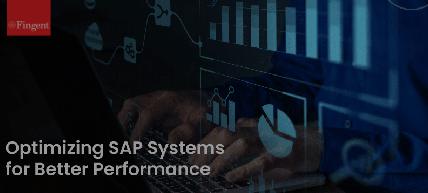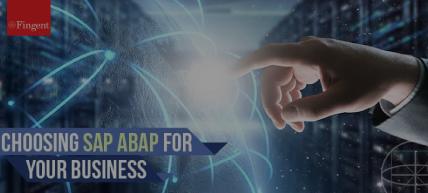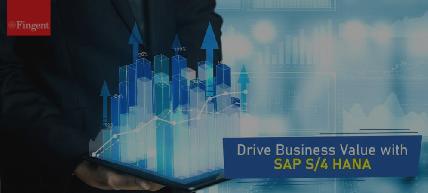SAP S/4HANA Services & Solutions
Driving sustainable business value by capturing the full potential of SAP S/4HANA
Business Significance of SAP S/4HANA
How does SAP S/4HANA accelerate business growth and innovation?
What is SAP S/4HANA?
SAP S/4HANA is the world’s most intelligent ERP software designed to simplify your business landscape. It facilitates accelerated deployment by lowering costs with a standardized digital core and improves business agility through an open, modular, scalable, and innovative platform. S/4HANA service management integrates crucial functions from various lines of businesses as well as industries and incorporates parts of SAP Business Suite Products.
- Intelligent technologies
- Experience management
- Business technology platform
- Cloud and mobile-first solutions
- Sustainability and innovation
- Interconnected value chains and flexible networks
- Predictive analytics and insights
What are the business benefits of SAP S/4HANA?
- Numerous opportunities to apply data and pivot to new business models in a short span of time
- Easier to expand into new markets by quickly bringing acquisitions into the ERP environment
- Lowers infrastructure ownership and maintenance costs by enabling public or private cloud deployments along with SAP’s virtualization
- Single source of facts to improve decision-making and complete business processes without leaving your current interface
- Faster predictive analytics and insights enable huge efficiency and time savings
- Embedded AI and machine learning applications improve modeling, predictive outcomes and forecasting
- Faster end-of-period closings with real-time reconciliation of accounting and up-to-the-minute reports
- Predictive maintenance, asset monitoring, and alerts in the industrial sector to avoid costly repairs or unanticipated shutdowns
- Simpler user interface that reflects standard business tasks on mobile devices for anytime, anywhere availability
- Automation of tedious routine tasks to streamline business processes and free up workers to focus on more productive actions
SAP S/4HANA is the new digital core that accelerates your journey towards the intelligent enterprise. Learn more about how SAP S/4HANA can transform your business to unlock new possibilities.
How do they differ?
Differences between ECC and SAP S/4HANA
SAP ECC
- Can run on third-party databases like Oracle, MaxDB, and IBM
- Traditional processes constrained by the legacy database
- Maintains separate customer and vendor files
- Finance (FI) General Ledger (GL) accounts are mapped to Controlling (CO) primary cost elements
- Can run on either a "classic" GL structure or the "new" GL structure
- Legacy graphical user interface (SAP GUI)
- Supports on premise deployment
- Lack of intelligent technologies
- ERP suite supported until 2027
SAP S/4HANA
- Runs only on SAP HANA, the in-memory database of SAP
- Intelligent processes enabled by new technology and SAP HANA
- Combines common data structure elements into a Business Partner record
- Structure of the universal journal is used to store both GL account and cost elements
- Uses only the new GL, which is a prerequisite for new asset accounting
- SAP Fiori - modern, customizable, and intuitive User Interface
- Complete choice of on premise, cloud, or hybrid deployment
- Embedded AI & ML, advanced analytics, and digital assistants with voice recognition
- Supported until 2040
Distinct business processes
SAP S/4HANA for different lines of business (LOBs)
SAP S/4HANA includes several modules that are classified into different lines of business (LOBs), each comprising functions for specific business processes.
S/4HANA Finance: Focuses on all the financial aspects of a business, including financial accounting, controlling, treasury and risk management, financial planning, financial close and consolidation.
S/4HANA Logistics: A collection of LOB modules that includes Sourcing and Placement, Extended Procurement, Manufacturing, Supply Chain, Asset Management, and several other modules centered around processes for supplier relationship management and supply chain management.
S/4HANA Sales: Comprises processes that are required to fulfill sales orders, including pricing, sales inquiries and quotes, promise checks, incompletion checks, repair orders, individual requirements, return authorizations, credit and debit memo requests, picking and packing, billing and revenue recognition.
S/4HANA R&D and Engineering: This module focuses on the product life cycle, including defining the product structure and bills of materials, product lifecycle costing, project and portfolio management, innovation management, management of chemicals or other sensitive materials used in development, and health and safety regulatory compliance.
Digital core LOB capabilities:Designed to meet specific requirements across various industry segments, such as Consumer Industries, Discrete Industries, Energy and Natural Resources, Financial Services, Public Service, and Service Industries.
Selecting the right S/4HANA solution for your industry segment is the key to achieving your IT and business objectives.
Factors to Count
Key considerations to note when building a business case for SAP S/4HANA
Defining a clear value proposition: Qualify and quantify the value of optimizing existing business processes and enabling new operating models.
Adopting the right S/4HANA migration strategy: Perform a detailed readiness assessment of the existing SAP solution, so you can develop an intelligent approach for converting your system to SAP S/4HANA.
Creating new business models: Scenarios where S/4HANA could provide competitive advantage, such as new supply chain and network models, insights into customer behavior and buying preferences, and integration of cloud-based services.
Re-engineering of existing data structures and transaction processing: Examples include faster period-end closing, profitability analysis, and workforce mobility and self-service.
Identifying candidates for migration: Assess the existing portfolio of legacy applications to eliminate weaker parts and use SAP Cloud Platform extensions to improve the effectiveness of well-functioning applications.
Understanding the benefits of cloud deployment: S/4HANA cloud is a subscription-based intelligent SaaS solution that provides large and rapid scalability, flexibility, and more software integration options.
Transitioning to SAP S/4HANA
Standard options for migrating from SAP ECC to SAP S/4HANA
There are three standard options for SAP S/4HANA migration:
New Implementation
As the name implies, new implementation refers to setting up a completely new ERP system that adopts standard next-generation processes and innovations. It requires decommissioning your old ERP, with only master data and open items/balances migrated to the new SAP S/4HANA system. Historical data is not covered, so the new system only contains the processes and data that are necessary for your future innovations.
- Best suited for companies that need a net new implementation
- Allows redesigning outdated processes based on the latest innovations in S/4HANA
- Eliminates clunky legacy data
- Commonly known as Greenfield migration approach
System Conversion
System conversion allows organizations to migrate from SAP ECC to SAP S/4HANA by converting their existing SAP environment without re-implementation and without major change or disruption to existing business processes. This method preserves your original system, including data, processes, and custom code.
- Best suited for those who do not want to abandon their custom code and processes
- Not suited for migrating to SAP S/4HANA Cloud
- Enables quicker adoption and development of new innovations
- Commonly known as Brownfield migration approach, which includes database migration and application conversion
Selective Data Transition
Selective data transition is a customized or hybrid approach that uses preconfigured transformation rules to extract specific master and transactional data sets. Migration to the new S/4HANA platform is based on legal entities or other organizational elements.
- Best suited for use cases where an organization with multiple ERP systems wants to consolidate all the ERP systems into a single source of truth
- Ideal for organizations that need more than just the master data and open items
- Enables the user (organization) to define a new configuration set and improve business processes
- Allows historical data to be kept, converted and transformed if required, to fit the new S/4HANA configuration
A stitch in time saves nine. A certified SAP partner helps you choose the right S/4HANA migration approach.
Pros & Cons of S/4HANA Migration
Benefits and challenges of SAP S/4HANA migration
Benefits
- Access to the latest technology, including AI, chatbots, and IoT
- Real-time analytics on consolidated data
- A simpler UI
- Automatic updates every quarter
- Process automation
- Easier-to-update business models
- Faster period-end financial closings
Challenges
- Data corruption and validation issues during migration
- Selecting the right architecture: cloud or on-premise
- Balancing between standardization and customization
- Overcoming resistance to change
- Lack of in-house competency and resources to handle migration
- Difficulties to respond effectively to changes (e.g. statutory, legal)
Expenses and Returns
Cost and ROI considerations for implementing SAP S/4HANA
Cost elements
- SAP software licensing and capital infrastructure costs
- Implementation and integration costs, app migration costs
- Maintenance and support costs of applications, hardware, and networks
- Change management, training, improvement, and adoption costs
- Cost of staff to design, build, and manage transition
- Type of deployment - on-premise, public or private cloud
Return on investment
- Increased revenue and customer retention
- Better end user productivity due to reduced run times
- Cost savings on previously licensed software and hardware
- Increased productivity of employees, both at client-facing and backend operations
- Accelerated collections due to simplified accounting capabilities
- Improved focus on higher-priority objectives
How do we help?
Our SAP S/4HANA services and implementation methodology
Our approach combines the best of SAP activate methodology with RISE with SAP services, preconfigured solutions, focused industry templates, automation solutions, and a modular and agile framework. We help you integrate strategy, process, policies, people, and technology to ensure that your organization is driven by the right insights and processes.
Our unique SAP S/4HANA service implementation methodology is a tried and tested practice with several successful implementations.
1. Prepare
- Project Setup
- Roadmap & Approach
- Initial System & Best Practices
2. Explore
- Delta Design & Fitment
- Solution Fit & Gap Analysis
- Activate Solution
3. Realize
- Configure & Customize
- Pilot Demos & Training
- User Acceptance
4. Deploy
- Go live
- PRD & Cutover
- Systems Ready and Masters Load
5. Support
- Open Items
- Fingent Help Desk
- Project Closure
Fingent’s SAP S/4HANA services and solutions
- S/4HANA on-premise or cloud deployment, global template and roll out
- Brownfield/Hybrid/Landscape Transformation/Selective Data Transition
- Finance Transformation, Procurement Transformation, and HCM Transformation
- Supply Chain and Logistics Transformation
- Application Development, Maintenance, and Support (ADMS)
- S/4HANA Business Case Development
- Detailed and focused SAP S/4HANA roadmap
- Help customers evaluate and define their ERP architecture
- Advisory for specific LOB solutions
- Convert to SAP S/4HANA on a fixed budget and schedule
- On-premise or cloud-hosted S/4HANA implementation
- Selective Data Transition (Hybrid approach)
- More flexibility, higher success rate, and lower cycle time
- Enhanced UX, lower costs and risks, and ongoing support services
- Detect challenges, define the business case, and decide where to start
- Pre-configured scenarios and process mining to mitigate risks
- Identify deployment and hosting options
- Perform pre-checks prior to implementation
- Functional scope and custom code analysis
- Buy service points based on anticipated usage
- One service point equals an hour of offshore support
- On-demand SAP Support: Pay as you go
- Bring down total support costs up to 50%
- Go for skill augmentation or complete outsourcing
- Pivot quickly and adapt to dynamic business scenarios
- Embrace innovations, reduce costs, and minimize downtimes
- Save time to focus on strategic business tasks
- Respond fast, optimize costs, and digitize finance functions
- Managed cloud application services to deploy, manage, monitor, and enhance your SAP cloud applications with reduced complexity and costs
- We work with leading cloud hyper scalers
- Cloud orchestration and automation services
- Achieve greater value from your IT investments
- Reduce cloud migration costs to bring down total cost-of-ownership
- Six core technologies: IoT, Machine Learning, Blockchain, Big Data, Analytics, and Data Intelligence
- Industry accelerators and packages to maximize ROI
- Freedom to choose any infrastructure provider (IaaS)
- Custom Fiori UX development
- Reliable and rapid go-live support
- 100% consistent and simplified UX
- Standard business tasks on mobile
With the right SAP partner by your side, planning your step-by-step migration to S/4HANA will be like a walk in the park.
Case Studies
SAP S/4HANA implementation: Fingent’s success stories
1. SAP S/4HANA system conversion for a high-tech manufacturer
Fingent enhanced the operational efficiencies and capabilities of a leading high-tech manufacturer by helping them convert from SAP ECC 6.0 to SAP S/4HANA. Conversion to SAP S/4HANA 1709 was performed by following the Lift and Shift Methodology along with comprehensive Fit-Gap Analysis.
- Digitized the organizational core, enabling 30-40% reduction in data footprint
- Testing, training, and hyper care support to ensure the stable functioning of the client’s SAP S/4HANA system
- Tremendous improvements in terms of operational efficiency, customer service, and ROI
2. Migration from SAP ECC 6.0 to SAP S/4HANA
Thermo Pads, a leading manufacturing firm, enhanced their sales and purchase processes and streamlined their finance models by migrating from SAP ECC 6.0 to SAP S/4HANA.
- Seamless integration with third-party software, such as bank process servers for payment processing and EBRS
- Upgraded from ECC to S/4HANA to fulfill the business requirements
- Streamlined workflows by importing catch-up transports from non-HANA systems to HANA systems
3. SAP S/4HANA implementation for improved business automation
By implementing SAP S/4HANA, a leading business in the Exploration and Production Industry achieved a process driven solution to handle day-to-day operations with less personnel intervention, reduced paperwork and enhanced preventive maintenance.
- Optimized resource utilization and improved user experience
- Better analysis of costs and profitability with enhanced payroll and costing systems
- Real-time actionable insights with accelerated financial processes
- Single integrated system across legal entities to achieve short term revenue goals
4. Migration from legacy ERP to SAP S/4HANA
Fingent helped Sonic Biochem, a global manufacturer and supplier of processed food items, to seamlessly migrate from their legacy system to SAP S/4HANA.
- Faster GST adaptation with 100% legal & statutory compliance
- Sustained business continuity during the entire transition phase
- Migration covers all taxable scenarios and requirements
With SAP S/4HANA at their core, Intelligent Enterprises are changing how work gets done, reacting in real time to critical insights and driving improved customer experiences.
Insights
More Insights on SAP S/4HANA

Ensuring SAP Security and Compliance: Six Best Practices To Follow!
Individuals and organizations are contributing to the global data boom every single day. And business hyperconnectivity creates new challenges in cyber security. Most organizations are adopting the “better safe than sorry”
Optimizing SAP Systems For Boosted Performance
Most organizations assume that their work is done once SAP is implemented. Consider this: Do you own a car you have never given for servicing? Or any piece of equipment that has never been serviced yet continues to work optimally? Absolutely not!


